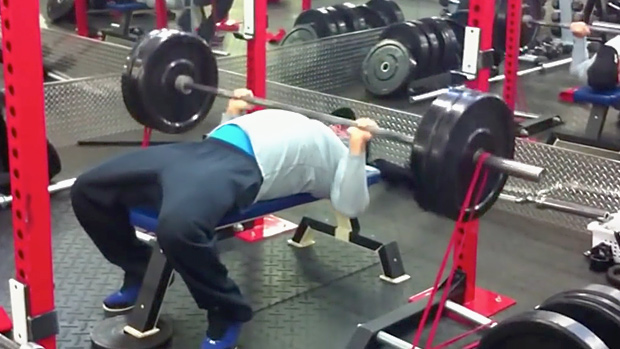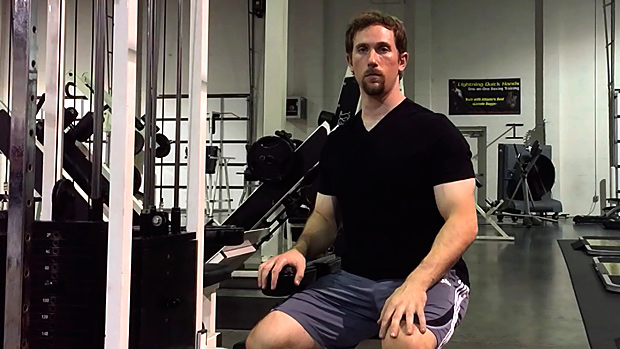20 Minutes of Muscle Gain & Fat Loss
Let's say you had only 20 minutes to spend at the gym. If you were to do your usual five sets of five reps with two minutes rest in between, that would eat up more than half of your workout. And don't even think about taking a bathroom break. Instead, choose one of these proven set-rep schemes and get the most out of your shortened workout.
Some purists would say that only beginners time their rest periods while experienced lifters go by feel. But if the classic 5x5 protocol takes you a half-hour due to excessively long breaks between sets, it's time to reevaluate your stance on using a timer.
One of the best ways to limit rest periods is to perform your sets on a designated time interval, usually "on the minute". For example, you could perform a 10-minute EMOM of five sets of five deadlifts on the even minutes (0:00, 2:00, 4:00, 6:00, and 8:00) and five sets of 10 push-ups on the odd minutes (1:00, 3:00, 5:00, 7:00, and 9:00).
From a strength standpoint, you're still getting your 25 deadlifts in with two minutes in between sets, which is enough time to allow you to use a fairly heavy load and still recover. You're also hitting your upper body in between with sets of 10 push-ups. Yes, training in this fashion will hurt, but it'll also be effective.
As sets of five reps become easy, increase reps, weight, or duration of the EMOM (12 minutes instead of 10 for example), or progressively decrease the time interval between sets, like doing a set every 55 seconds.
Most lifters perform their work sets at or close to failure, then rest and repeat. Density training flips this script. Instead of going to failure on every set, you do just a few reps of one exercise, leaving a large number of reps in the tank. Then you move to a non-competing exercise (upper body then lower body), perform it in the same fashion, and repeat for a designated amount of time.
For example, you might select a 10 rep max load for two exercises like squats and overhead presses. Set a timer for 10 minutes and do three squats and three overhead presses, limiting the rest as much as possible, and continue for 10 minutes. By leaving so many reps in the tank, you're able to return to each exercise much more quickly than if you were working closer to failure, which will result in greater volume over that 10-minute time frame.
To progress, increase reps incrementally (alternately perform sets of 4), increase load, or extend the duration of the density training bout by a few minutes.
The very definition of a maximum rep set is that you can't perform more than the specified number of reps. If you can squeeze out another rep, there are only two explanations: either the rep was ugly or you weren't working at your true max.
If you alter your definition of a set slightly, though, there could be a third explanation. Imagine doing a quad-burning set of high-rep squats with your 10RM. The catch is that you have to get 12 reps.
To do this, you somehow have to conserve energy. It might look like this:
- Do 6 straight reps
- Rest for a few seconds at the top of the squat
- Do a couple more reps
- Rest again without racking the bar
- Repeat until you hit 12 total reps
You can use this rest-pause method any time to tack on one or more small sets of a few extra reps on virtually any exercise. You can even re-rack the bar or put the weights down between sets if you want. It's not cheating if you plan to do it. The less you rest and the more extra reps you perform, the more "dense" – and painful – the workout will be.

Taking the rest-pause idea one step further, what if, instead of taking breaks as needed, you actually planned them out, taking them even before you needed them in order to stave off fatigue?
Going back to the squat example, to get those twelve reps you could break it down into 4 "mini-sets" of 3 reps with 10 seconds rest in between– just enough time to catch your breath, but not so much to give your muscles a chance to recover. It would look like this:
- 3 reps
- 10 seconds rest
- 3 reps
- 10 seconds rest
- 3 reps
- 10 seconds rest
- 3 reps
- = 12 total reps
The entire cluster set would take just 30 extra seconds (three 10-second breaks), yet you'd be able to perform a greater number of reps than you normally would at the given weight.
To increase the degree of difficulty, perform fewer mini-sets and more reps within each one (like 3 mini-sets of 4 reps) until you're performing all the reps continuously and your previous 10RM is now your 12RM.
Circuit training is a well-known method for getting a lot of volume in a short period of time. In its most common usage, it includes specified periods of work and periods of rest for transitioning between exercises, such as 40 seconds on, 20 seconds off.
Complexes go beyond basic circuit training by eliminating the rest periods. To perform a complex, simply choose one implement (barbell, dumbbells, or kettlebells) and do several exercises in rapid succession, all with the same load. In order to spread out the fatigue, alternate between upper and lower body exercises.
Here's an example using a pair of dumbbells:
- Front Squat
- Bent-Over Row
- Overhead Press
- Romanian Deadlift
- Curl
Do 6 reps of each without putting the dumbbells down. Repeat the cycle as many times as you like. Although the load will have to be fairly light, as dictated by the limiting exercise (likely the curls in the example), the total amount of time under tension will provide a hypertrophy stimulus in addition to building conditioning.
To make the complex even more challenging, add reps (up to 10) and then increase the weight.
In density training, you perform alternating sets of two non-competing exercises. Combination exercises follow a similar pattern, only instead of alternating exercises every set, you alternate every single rep. Each exercise serves as a very brief rest period from the other, allowing you to do more reps of each in a given time period.
Similar to the density-training example, you could alternate between reps of front squats and overhead presses. The load will be dictated by the exercise you're weaker in – the overhead press in this case.
Other tried-and-true pairings for combo exercises include:
- Hang Clean and Front Squat
- Deadlift and Overhead Press
- Curl and Overhead Press
Use your imagination. The possibilities are endless. Progress by increasing total reps or load, or strive to perform the back-to-back reps with more fluidity. For example, use leg drive from the front squat to initiate the overhead press.





